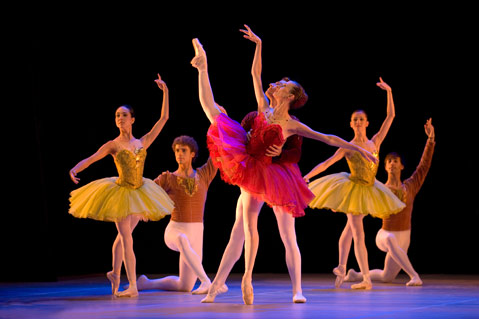Corella Ballet Castilla y León at the Granada
Young Spanish Company Is Going Places

The high-speed trains that crisscross Europe are in every way a symbol of forward motion: Modern, sleek, and efficient, they shoot past farmland and over ancient bridges, bearing commuters to the same destinations that have been hubs of human activity for more than 2,000 years. Michael Nyman captured their energy and excitement in his Musique à Grand Vitesse, composed for French train company TGV in the early ’90s, and in 2006, choreographer Christopher Wheeldon adapted it for a new ballet: “Danse à Grand Vitesse” (DGV).
This vibrant, pulsing work closed Corella Ballet’s Santa Barbara premiere at the Granada on Monday night. It was an inspired choice for the young Spanish company, which is itself breaking new ground on old territory and rapidly gathering speed. American Ballet Theatre (ABT) principal dancer Ángel Corella founded the company in his native Spain just three years ago, and already they’re touring the world. Corella emphasizes his company’s classical orientation. At the same time, he’s responding to the gravitational pull of contemporary work.
If DGV captures the dynamic internationalism of today’s arts world, María Pagés’s “Soleá” is rather more focused in time and space. It’s an eight-minute duet for Corella and his sister Carmen set to classical Spanish flamenco music, and its call-and-response style gives these two a chance to play on the line between rivalry and mutual celebration. Given everything he’s accomplished in launching a new company, it’s easy to forget Corella’s one of the world’s most acclaimed performers. Then he whips off a triple pirouette as naturally as a dog shakes off water, and you remember. For all the fabulous fouettés and bourrées in “Soleá,” its sweet spot was the curtain call, when brother and sister slung their arms over one another’s shoulders, their bodies hunched in easy laughter.
Far more formal was Clark Tippet’s “Bruch Violin Concerto No. 1,” a neoclassical work originally set on ABT in the ’80s that gave the company a chance to show off its polished corps de ballet against four pas de deux. Ballerinas in red and pink were all flourish and fanfare with diving arabesque penchées and sweeping lifts; those in cooler colors were more restrained. It was in “Clear,” Stanton Welch’s work created on ABT in the weeks immediately following 9/11, that the young Corella Ballet seemed to hone in on what they’re really about: stellar technique and athleticism, impassioned performance, and as the light fades, an embrace, reminding us of the human connections that lie at the heart of it all.



